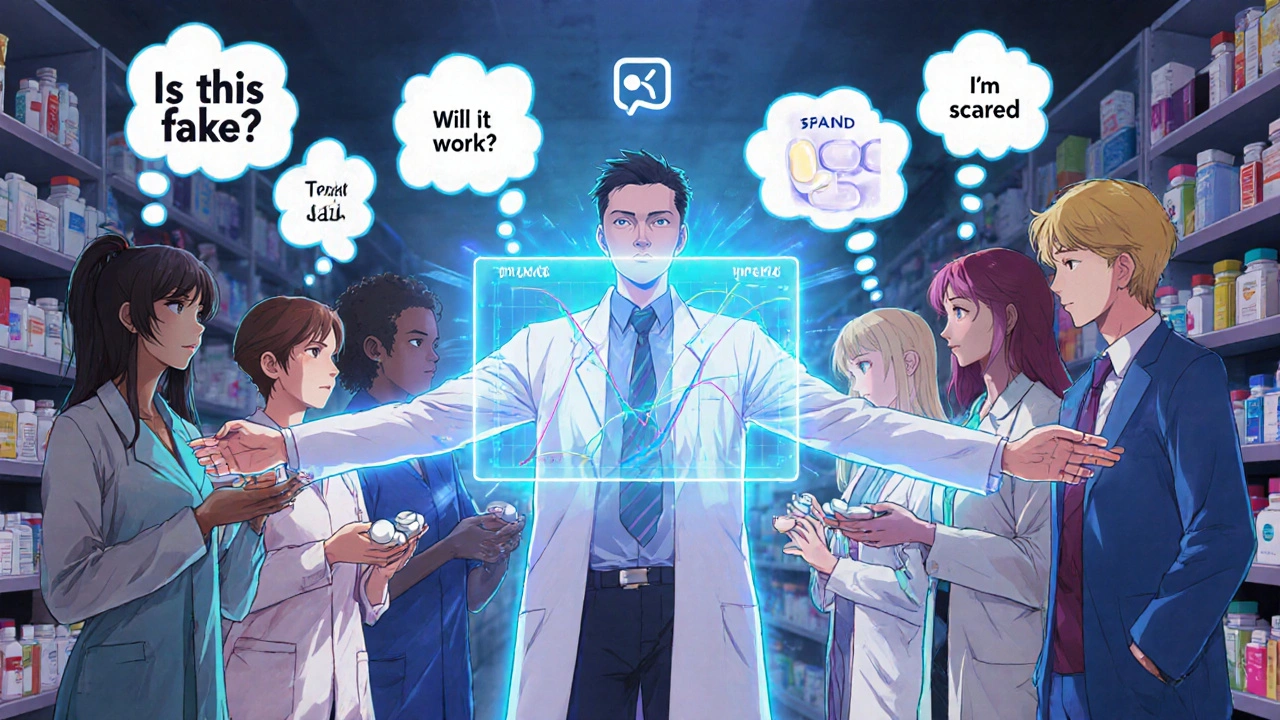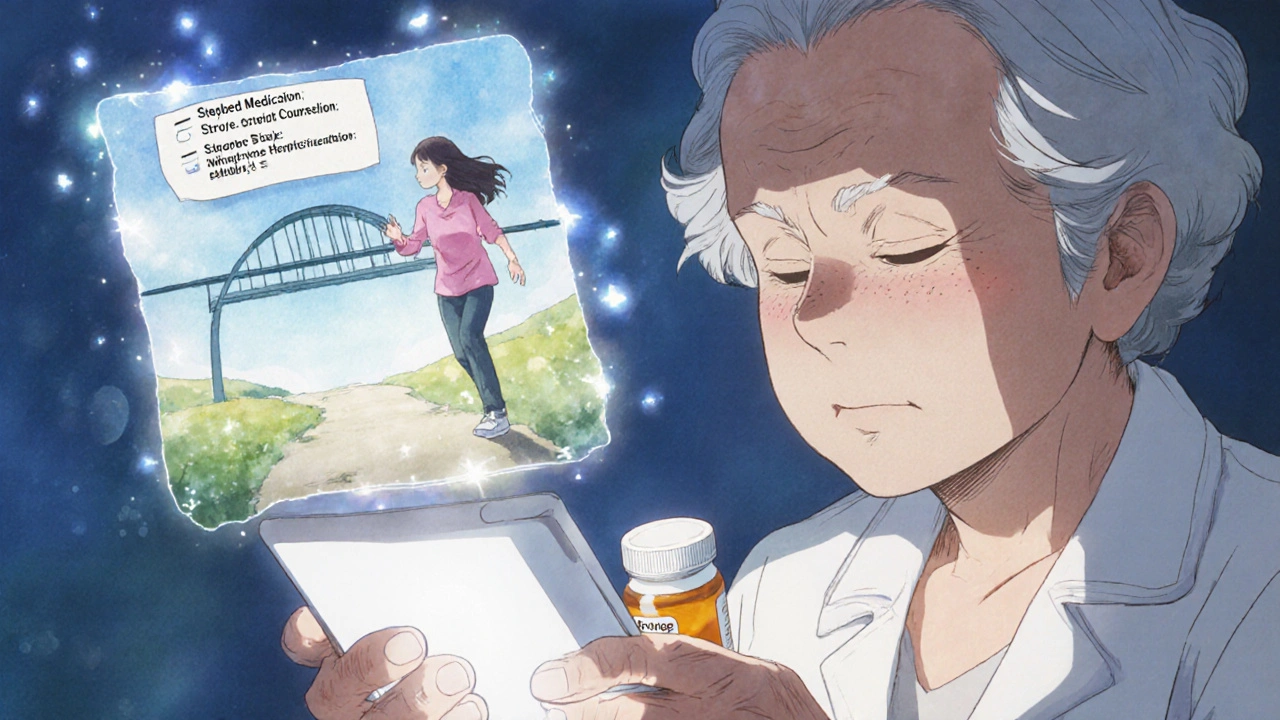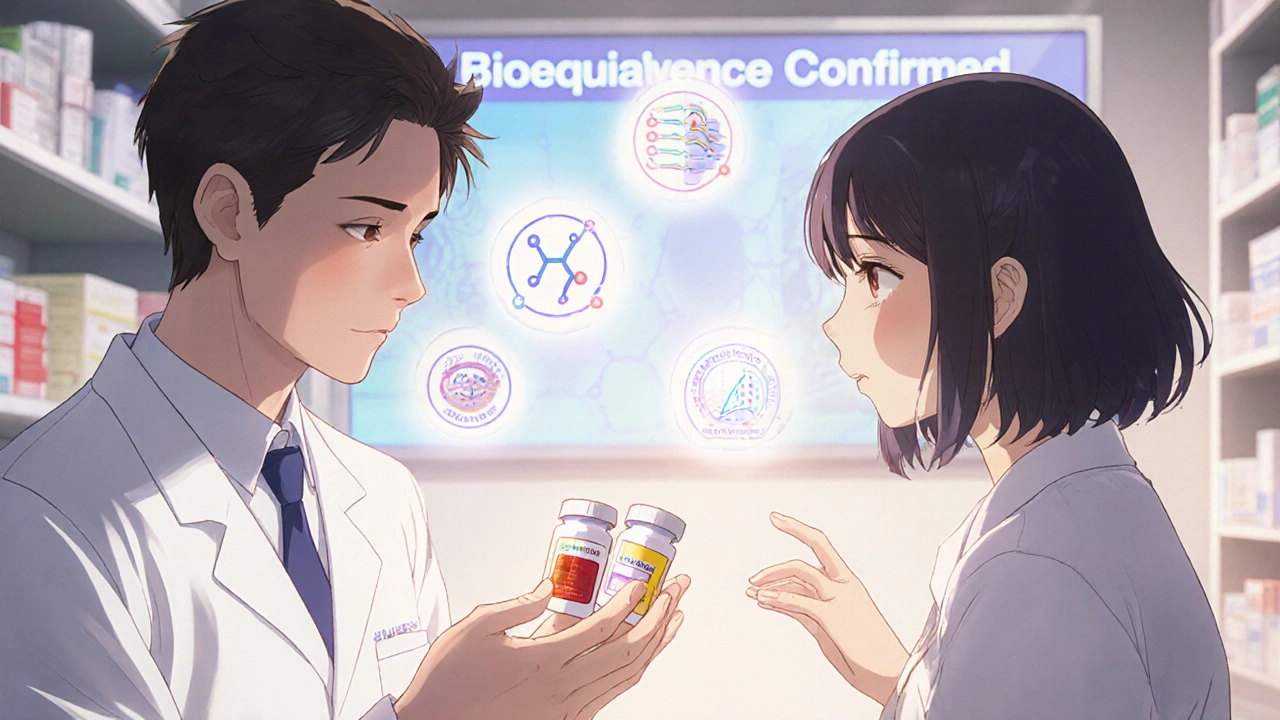When a patient picks up a prescription and sees a pill that looks completely different from what they’re used to, panic can set in. Generic medication isn’t a downgrade-it’s the same active ingredient, same effectiveness, same safety profile. But if the pharmacist doesn’t explain that clearly, the patient might stop taking it altogether. That’s not just a missed dose-it’s a public health risk.
Why Generic Counseling Isn’t Optional
In 1990, U.S. federal law made it clear: pharmacists must counsel patients on every prescription. That rule didn’t change when generics became the norm. Today, 90.7% of all prescriptions filled in the U.S. are generics. Yet, nearly half of patients still believe generics are less effective. A 2023 Consumer Reports survey found that 43% of people think generic drugs don’t work as well. Another 37% worry they cause more side effects. And 28% believe they take longer to kick in. These aren’t myths patients made up. They’re fears fueled by silence. When a pharmacist just says, “It’s the same thing,” without showing how or why, patients don’t believe it. That’s why counseling isn’t a courtesy-it’s a legal requirement under OBRA ’90 and enforced in all 50 states. CMS and ASHP both say: if you don’t explain the switch, you’re not doing your job.The Five Must-Discuss Points for Generics
Generic counseling isn’t just about saying, “This is cheaper.” It’s about building trust. Here’s what every pharmacist needs to cover, every single time:- Confirm the patient’s identity. Don’t assume. Ask their name, date of birth. This isn’t bureaucracy-it’s safety. You’re about to give them a new pill. Make sure it’s the right person.
- Explain why the substitution happened. Say it plainly: “Your insurance requires a generic version. It’s approved by the FDA as equally effective.” Mention that 49 states allow pharmacists to substitute unless the doctor says “dispense as written.”
- Describe the physical differences. This is the biggest trigger for non-adherence. “The brand was blue and oval. This one is white and round. That’s because the inactive ingredients-like dyes or fillers-are different. But the medicine inside? Identical.” Show a picture if you can. Many pharmacies now have printed side-by-side images on hand.
- Reaffirm bioequivalence. Don’t just say “it’s the same.” Explain what that means: “The FDA requires generics to deliver the same amount of active ingredient into the bloodstream within the same time frame as the brand. Studies show no difference in how well they work.” Cite the FDA’s 90-110% bioequivalence range. That’s not a guess-it’s science.
- Use the teach-back method. Ask: “Can you tell me how you’ll take this?” or “What would you say if someone asked you why you’re taking this pill?” If they say, “I think it’s for my blood pressure,” but can’t explain the dose or timing, you haven’t finished. This step cuts non-adherence by up to 40%.
What Happens When You Skip These Steps
A patient in Sydney, Australia, stopped taking her blood pressure medication because the generic looked different. She didn’t call her doctor-she just stopped. Two weeks later, she had a stroke. Her story isn’t rare. Reddit threads, pharmacy review sites, and NIH studies all point to the same pattern: patients stop taking generics because they think they’re fake, wrong, or dangerous. One patient wrote on Trustpilot: “I was rushed. The pharmacist handed me the pills and said, ‘It’s generic.’ I didn’t ask questions. I thought I was being given the wrong medicine.” That’s not a patient failure. That’s a counseling failure. The data is clear: patients who get proper generic counseling are 68% more likely to believe their medication works. Those who don’t? They’re 3 times more likely to skip doses or quit entirely. And when that happens, hospitalizations go up. Costs go up. Lives are at risk.
Time Constraints Are Real-But Not an Excuse
Pharmacists average just 1.2 minutes per patient for counseling. That’s not enough to explain bioequivalence, show pill images, and do teach-back. But you don’t need more time-you need better structure. Use a checklist. Many pharmacies now use digital prompts that pop up when a generic is dispensed. They remind you: “Confirm identity. Explain substitution. Describe appearance. Reaffirm bioequivalence. Verify understanding.” CVS trains staff for 45 minutes a year on this. Walgreens does 30. If your pharmacy doesn’t have a system, build one. Start with a printed card on the counter: “Your Generic Medication-What You Need to Know.” Even in a busy pharmacy, you can do this in 90 seconds. Say: “This is your generic version of [brand]. It’s the same medicine, just a different shape and color. It works just as well. Can you tell me how often you take it?” That’s it. You’ve covered the core.Language, Culture, and Accessibility Matter
Title VI of the Civil Rights Act requires pharmacies to provide language assistance. If a patient speaks limited English, you can’t just hand them a leaflet in English. You need an interpreter, a translated card, or a video in their language. Many pharmacies now use tablet-based tools with multilingual counseling videos. Also, consider cultural beliefs. Some patients believe “natural” means better. Others think a more expensive pill must be stronger. Don’t assume. Ask: “Have you used generics before? What was your experience?” Listen. Then correct gently.
Documentation Isn’t Busywork-It’s Protection
CMS updated its rules in February 2024: you can’t just check a box that says “counseling provided.” You must document what you discussed. Did you explain appearance? Did you confirm understanding? Did you use teach-back? California requires specific checkboxes. Texas allows general notes. But if you’re audited and can’t prove you explained the switch, you’re liable. Use your pharmacy’s EHR system. If it doesn’t have a generic counseling template, ask for one. Or create one. A simple note like: “Explained generic substitution. Showed pill comparison. Patient confirmed understanding via teach-back” is enough.The Future Is Targeted, Not Generic
By 2026, AI tools will scan patient history and flag those most at risk of non-adherence to generics. A 72-year-old with diabetes who stopped a generic statin last year? The system will flag them. The pharmacist gets a prompt: “Patient previously discontinued generic simvastatin due to appearance change. Recommend visual aid + teach-back.” Pharmacies are also tying counseling to value-based payments. Medicare is starting to reward pharmacies that show improved adherence through generic counseling. That means better pay for better care.Final Thought: You’re the Bridge
Doctors write the script. Pharmacies fill it. But you’re the one who makes sure the patient understands it. Generics save the system billions. But they only work if patients take them. And patients only take them if they trust them. Your job isn’t to sell cheaper pills. It’s to stop fear before it starts. One conversation. One explanation. One moment of clarity. That’s all it takes to keep someone healthy.Do pharmacists have to explain generic substitutions by law?
Yes. Federal law under OBRA ’90 requires pharmacists to counsel patients on all prescriptions, including when switching to generics. All 50 U.S. states enforce this, with variations in documentation. Some states require explicit notification of substitution; others require it only if the patient asks. But in every state, counseling must occur, and pharmacists are legally responsible for ensuring understanding.
Are generic drugs really as effective as brand-name drugs?
Yes. The FDA requires generics to have the same active ingredient, strength, dosage form, and route of administration as the brand. They must also prove bioequivalence-meaning they deliver the same amount of medicine into the bloodstream at the same rate. Studies show no meaningful difference in effectiveness or safety. Generics are tested just as rigorously as brand-name drugs.
Why do generic pills look different from brand-name ones?
The active ingredient is the same, but the inactive ingredients-like colorants, fillers, and coatings-are different. These are changed to avoid trademark infringement and to reduce costs. The shape, color, or size doesn’t affect how the medicine works. In fact, many brand-name drugs change their appearance over time too. The key is to explain this difference upfront so patients don’t mistake it for a different drug.
What if a patient refuses a generic?
If a patient refuses, you must document their refusal and notify the prescriber if requested. Some patients refuse because of cost concerns, misinformation, or past negative experiences. Offer to call the doctor to see if a brand is medically necessary. If not, explain again why the generic is safe. Never pressure, but always inform. Many patients change their mind after a clear explanation.
How can pharmacists fit counseling into a busy day?
Use structure, not time. A 90-second script works: confirm identity, explain substitution, describe appearance, reaffirm bioequivalence, and use teach-back. Use digital prompts, printed visuals, and pre-written notes. Train pharmacy technicians to offer counseling availability-but only pharmacists can deliver it. Prioritize high-risk patients: elderly, new prescriptions, multiple meds, or those with past non-adherence. Even one well-done conversation makes a difference.
Can pharmacy technicians do generic counseling?
No. Only licensed pharmacists can provide counseling. Technicians can inform patients that counseling is available, hand them printed materials, or answer basic questions like “Where do I pick this up?” But explaining bioequivalence, addressing fears, or verifying understanding must be done by the pharmacist. This is a legal requirement in all states.



Pallab Dasgupta
November 23, 2025 AT 17:52This is the kind of post that makes me want to hug every pharmacist I’ve ever met. Seriously. You’re not just handing out pills-you’re preventing strokes, saving lives, and fighting misinformation one confused patient at a time. I had a relative who stopped her meds because the generic looked like a candy pill. She thought it was a joke. We almost lost her. Don’t let silence kill.
Jennifer Griffith
November 24, 2025 AT 07:49lol generics are just brand name drugs with different coloring. i mean come on. i swear half the time the fillers are worse. my knees hurt after taking the generic ibuprofen. brand name? zero issues. just sayin.
Ellen Sales
November 24, 2025 AT 09:24Every time I hear someone say 'it's just a generic' I want to scream. It's not 'just' anything. It's science. It's regulation. It's FDA-approved bioequivalence. And yet, we treat it like a discount aisle at Walmart. The fact that patients think color = potency? That's not ignorance-it's neglect. And pharmacists? You're the bridge. Don't let the bridge collapse.
Josh Zubkoff
November 25, 2025 AT 08:24Let’s be real-this whole ‘generic counseling’ thing is just corporate cost-cutting dressed up as patient care. The FDA doesn’t require generics to be identical, just ‘bioequivalent’-which means a 90-110% window. That’s a 20% swing. Two people on the same dose could be getting wildly different effects. And don’t get me started on the inactive ingredients. Some generics have more fillers than actual medicine. It’s not a conspiracy-it’s capitalism. And now we’re making pharmacists the PR team for Big Pharma’s budget cuts?
Emily Craig
November 25, 2025 AT 10:24Ohhh so now we’re blaming pharmacists for patients being dumb? Really? If someone doesn’t read the label or ask a single question, that’s on them. You can’t hold someone’s hand forever. Also-why are we pretending this is a new problem? People have been afraid of generics since the 80s. Stop acting like this is the first time someone thought a white pill was ‘fake.’
Dolapo Eniola
November 25, 2025 AT 23:29USA thinks it's the only country that knows medicine! In Nigeria, we don't even have generics-we have fake drugs sold in open markets. At least you have FDA. We have 'Nigerian Viagra' in plastic bags. You think your problem is big? We have people dying because they think 'generic' means 'poison.' You need to fix your own house before lecturing the world. 😅
Arup Kuri
November 26, 2025 AT 04:02Generics are government mind control. They want you dependent on pills. The real medicine is sunlight, fasting, and prayer. Why do you think the brand names are so expensive? Because they know the truth is hidden. The FDA is owned by Big Pharma. The color change? That’s to track you. They know who’s taking what. Wake up.
Timothy Sadleir
November 27, 2025 AT 23:25One must consider the epistemological framework within which pharmaceutical substitution occurs. The ontological identity of the active ingredient does not necessarily equate to phenomenological equivalence in patient experience. The placebo effect, though empirically measurable, remains a metaphysical variable that cannot be quantified by bioequivalence metrics alone. Thus, the psychological dissonance induced by altered pill morphology may constitute a legitimate therapeutic concern, irrespective of pharmacokinetic parity.
Patricia McElhinney
November 28, 2025 AT 14:58Actually, the FDA requires generics to be within 85-115% bioequivalence, not 90-110%. You’re wrong. And don’t even get me started on the fact that some generics have different release profiles-immediate vs extended. That’s not ‘the same.’ That’s dangerous. And the teach-back method? You think a 90-second script fixes systemic neglect? Please. This article is full of lies disguised as advice.
Andrew Camacho
November 29, 2025 AT 03:56Let me just say-this is the most emotionally manipulative piece of corporate propaganda I’ve read since the ‘your pharmacist loves you’ ads. You’re telling us to trust the system? The same system that lets a $1000 brand drug become a $2 generic overnight? The same system that lets the same company own both the brand and the generic? And now you want us to believe the pill looks different but works the same? Bullshit. I’ve seen patients crash after switching. You’re not protecting them-you’re enabling greed.
prasad gaude
November 30, 2025 AT 06:39Back home in Kerala, our pharmacists sit with you for 15 minutes. They ask about your diet, your sleep, your stress. They show you the pill. They draw it. They make you repeat it. And yes-they still use paper logs. No digital prompts. Just human connection. Maybe the answer isn’t more checklists. Maybe it’s more time. More presence. More tea with the patient.
Srikanth BH
November 30, 2025 AT 16:19Man, I wish my grandma’s pharmacist did this. She stopped her blood pressure meds for 3 months because the generic was round instead of oval. She thought she was getting ‘fake medicine.’ We found out when she ended up in the ER. If someone had just shown her the side-by-side picture? She’d still be here. This isn’t just policy-it’s love in action.
Rachel Villegas
November 30, 2025 AT 18:33Agreed. This is exactly why I became a pharmacist. I’ve had patients cry because they thought they were being ‘downgraded.’ I’ve had them thank me for taking the time. It’s not about the time-it’s about the care. One person at a time. That’s how change happens.
Amy Hutchinson
December 2, 2025 AT 03:07my pharmacist just yelled at me to take it and left. i dont care if its the same. it looks weird and i dont trust it. also why do they all taste like plastic?
Archana Jha
December 3, 2025 AT 22:49Generics are a scam. The FDA lets them use fillers that cause cancer. I read it on a blog. Also, the color change is to make you feel like you’re being watched. The government uses the dyes to track your blood pressure. They’re building a database. You think this is about health? It’s about control. I switched back to brand. I’m not a lab rat.
Jefriady Dahri
December 4, 2025 AT 21:25Bro, I work at a pharmacy in Delhi. We don’t have time for 5-point scripts. But we do this: we hand them a printed card with a photo of the brand vs generic. We say: ‘Same medicine. Different wrapper. Like your phone case.’ Then we ask: ‘You good?’ Most say yes. Some ask more. We answer. No checklist. Just care. And yeah-we still use emojis. 🙌💊
Elise Lakey
December 6, 2025 AT 13:03I’ve been on generics for 12 years. Never had an issue. But I’ve also had pharmacists who took 2 minutes to explain everything. That’s the difference. It’s not the pill-it’s the person handing it to you. When they care, you believe it. When they don’t? You panic. Simple as that.
Agastya Shukla
December 6, 2025 AT 16:02The bioequivalence range is 80-125% for narrow therapeutic index drugs, not 90-110%. You’re misrepresenting FDA guidelines. And the ‘teach-back’ method? It’s not validated for pharmacogenomic populations. We’re applying Western clinical models to heterogeneous patient groups without cultural adaptation. The assumption that ‘one size fits all’ counseling is a form of epistemic violence. Also, why are we ignoring the role of polypharmacy in non-adherence? This is reductionist.